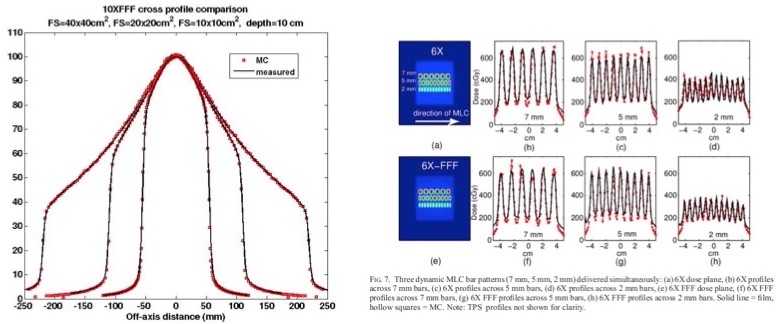High Precision Radiotherapy – SABR Research Group
Stereotactic Ablative Radiotherapy (SABR), previously known as Stereotactic Body Radiation Therapy (SBRT), requires the precise delivery of a therapeutic dose in less than 5 fractions. SABR has been shown to be effective for spine and liver treatments, and it is currently becoming the standard of care for inoperable non-small cell lung cancer (NSCLC). Accurate tumour delineation and subsequent localization is critical for target coverage, as well as spatial avoidance of the healthy surrounding tissue.
The first SABR site introduced in Kelowna was lung SABR. For these patients we typically utilize abdominal compression to minimize the motion of lung tumours, and we also acquire 4D-CT images of the entire respiratory cycle with Varian’s Real-time Position Management (RPM) system . For image-guidance during treatment, the Varian Truebeam on-board imaging (CBCT) is used to localize the target. Treatment delivery is expedited with the high dose rate Flattening-Filter-Free (FFF) beam as well as the Volumetrically Modulated Arc Therapy (VMAT) technique.
In addition to lung patients, we have recently introduced high-precision brain treatments and are working on the introduction of SABR treatments for liver and spine. Ultimately we will have the ability to treat a wide range of metastatic disease and provide another option for oligoprogression as well.
SABR research has encompassed Monte Carlo simulations, 4D radiotherapy, Trajectory-based treatment optimization and treatment delivery verification.
Monte Carlo methods in Radiotherapy
The Monte Carlo (MC) method of radiation transport is a numerical solution to the Boltzmann transport equation using the fundamental laws of particle physics interactions. These laws are governed by Quantum Electrodynamics, the most successful field of theoretical particle physics. The Monte Carlo method has been established as the most accurate method to calculate dose in a heterogeneous tissue environment and for small field sizes.
Volumetric Modulated Arc Therapy (VMAT) with flattening filter free beams (high dose rate) significantly reduces the treatment time and is beneficial for Stereotactic Ablative Radiosurgery treatments (SABR). However, most commercial treatment planning systems still struggle to provide accurate dosimetry for small field sizes and inhomogeneous media, which are both relevant concerns especially for SABR lung treatment. Thus, MC simulations are of particular relevance for dosimetric validation of lung SABR treatments. We have a dedicated Linux cluster running our MC applications using the BEAMnrc Monte Carlo code.
Linac commissioning:
The accuracy of the Monte Carlo calculated dose distribution is dependent on the accuracy of the Monte Carlo radiation beam model of the linear accelerator. In collaboration with medical physicists at the BC Cancer Agency Vancouver Cancer Centre, we have validated the phase-space files for the Varian TrueBeam linac for flattening filter free beams and implemented a model of the high definition MLC (HD120MLC).

Treatment plan verification:
In collaboration with the Vancouver Cancer Centre, we have developed and validated a MC based VMAT QA. This VMAT quality assurance tool has been used clinically to verify all VMAT treatment plans at the Vancouver Cancer Centre. Current developments include calculating the dose distribution on the patient anatomy and improving the automation of the process.

Dose distribution comparison between Monte Carlo (left) and treatment planning system (right) on a water-equivalent phantom.
Dose calculation algorithm verification:
Current research projects include assessing the accuracy of commercial dose calculation algorithms in inhomogeneous medium and for small field sizes using Monte Carlo simulations and GafChromic film measurements.
People
4D Radiotherapy
Volumetric Modulated Arc Therapy combined with Flattening Filter-Free beams (high dose rate) significantly reduces the treatment time and is beneficial for stereotactic ablative radiosurgery treatments (SABR). The interplay between the tumor motion and the radiation beam modulation can lead to delivered dose distributions which differ from the planned doses.
In collaboration with Dr. Steven Thomas (Vancouver Cancer Centre) and Vicky Huang (Fraser Valley Cancer Centre), we are developing a method to accurately calculate the dose distribution in 4D taking into account the tumor motion, the field modulation and the treatment starting phase.

Isodose lines and dose profile comparison between the treatment planning calculations (thick lines) which does not include the interplay effect and measurement (thin lines) including the interplay effect.
People
Trajectory (4π) treatment optimization and verification
The new generation of Linac, manufactured by Varian Medical System and called TrueBeam Linac, are installed at the BC Cancer Agency Centre for the Southern Interior. TrueBeam’s advanced control features are designed to allow complex three dimensional trajectory beam delivery by dynamically moving multiple components simultaneously while the radiation beam is on using TrueBeam’s Developer Mode. It is envisioned that by using the extra degrees of freedom of motion available with TrueBeam, it is possible to create optimal dose distributions that are not achievable otherwise. Several clinical sites stand to benefit from reduced treatment times and decreased normal tissue toxicity using trajectory based treatment delivery. However, no commercial treatment planning system is able to calculate dose distributions corresponding to this range of beam trajectories and patients will not benefit from these advantages until a treatment plan optimization for trajectory based treatment is developed.
Our research focuses on trajectory treatment plan optimization and treatment delivery verification. The current plan optimization algorithms are incapable to utilize the additional degrees of freedom and would require exponentially longer optimization time. This N dimensional problem requires new optimization techniques to fully exploit the benefit of trajectory based treatments. Before trajectory based treatments can be used clinically, new treatment delivery verification tools are also necessary.
We are developing an open source framework to interface the TrueBeam Developer Mode to the widely used Monte Carlo dose simulation platform BEAMnrc/DOSXYZnrc. This new open source framework will enable TrueBeam users to calculate dose distributions and to validate machine performance in a multitude of treatment configurations not currently available for clinical use.

Dose distribution measured with GafChromic film (left) and calculated with Monte Carlo (right) for a VMAT plan that includes couch rotation and translation and collimator rotation.
Other research areas include, but are not limited to:
- Development of Quality assurance methods for trajectory based treatment
- Trajectory treatment optimization using evolutionary algorithms